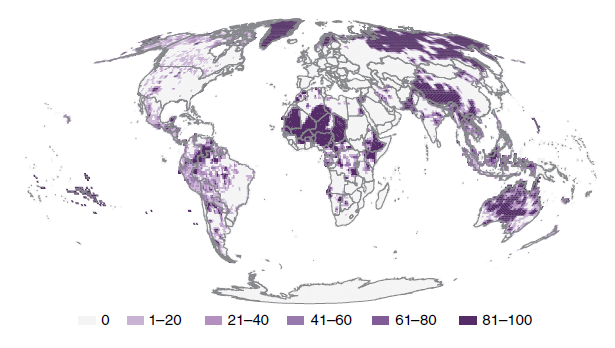News
Indigenous lands are globally important for conservation, new study finds

News | Jul 2018
Indigenous Peoples own or manage at least a quarter of the world’s land surface according to a new study published this week in the journal Nature Sustainability.
The study brings together global spatial information on indigenous lands for the first time and estimates the overlap between these lands and protected areas and human anthropogenic biomes.
The 38 million square kilometres are spread across 87 countries or politically distinct areas and overlap with about 40% of all terrestrial protected areas. This scale of spatial overlap demonstrates the vital role indigenous peoples’ play in protected areas management.
“Understanding the extent of lands over to which Indigenous Peoples retain traditional connection is critical for several conservation and climate agreements”, said Professor Stephen Garnett from Charles Darwin University in Australia who led the international consortium that developed the maps.
“Not until we pulled together the best available published information on Indigenous lands did we really appreciate the extraordinary scale of Indigenous Peoples’ ongoing influence,” he said.
The results add to the growing evidence that recognising indigenous peoples’ rights to land, benefit sharing and institutions is essential to meeting local and global conservation goals.
“In many countries Indigenous Peoples are taking an active role in conservation,” says Professor Neil Burgess, Chief Scientist at UNEP-WCMC. “This new research shows the huge potential for further collaborative partnerships between Indigenous people conservation practitioners and governments. This should yield major benefits for conservation of ecologically valuable landscapes, ecosystems and genes for future generations.”
The results will contribute to global policy recognition of the conservation value of indigenous peoples’ lands, including the Strategic Plan for Biodiversity 2011-2020 and the UN Sustainable Development Goals. The study should have particular value for the Intergovernmental Science-Policy Platform on Biodiversity and Ecosystem Services (IPBES) which is co-ordinating efforts to ensure the earth continues to provide the services people, animals and plants need to survive.
“We have been looking for an overview of Indigenous influence for some time,” says Professor Molnar Zsolt from the IPBES Indigenous and Local Knowledge Task Force. “What these new maps show us is that understanding Indigenous perspectives are essential when negotiating local or global conservation agreements.”
The paper is available here: https://www.nature.com/articles/s41893-018-0100-6
Have a query?
Contact us
communications@unep-wcmc.org
